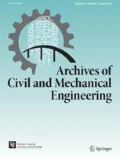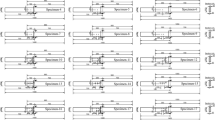Abstract
This study presents a newly developed timber–glass point connection intended to strengthen existing timber elements in a reversible and visually unobtrusive manner. The new connection consists of an aluminium insertion, two-component structural bonding epoxy resin adhesive, and self-tapping screws. The connection offers the possibility of easy attachment and detachment of the glass element from the strengthened timber element. Seven timber–glass specimens were constructed to perform an experimental investigation of the shear load-bearing capacity and load-slip behaviour of the connection. The aluminium insertion is bonded to a tempered glass strip with a hole and is screwed to the spruce timber block. The timber–glass connection preparation process is thoroughly presented. A special testing apparatus was developed to perform the experiments on a hydraulic universal testing machine. The experimental results are evaluated using analytical expressions and a finite-element simulation. The average connection load-bearing capacity obtained from the experiments of the analysed specimen was 13.31 kN, and the average slip modulus was 20.48 kN/mm. All connections failed on account of self-tapping screw failure, whereas the tempered glass strips remained undamaged.


















Similar content being viewed by others
References
Premrov M, Zlatinek M, Štrukelj A. Experimental analysis of load-bearing timber–glass I-beam. Constr Unique Build Struct. 2014;4:11–20.
Furtak K, Rodacki K. Experimental investigations of load-bearing capacity of composite timber–glass I-beams. Arch Civ Mech Eng. 2018;18:956–64. https://doi.org/10.1016/j.acme.2018.02.002.
Hamm J. Tragverhalten von Holz und Holzwerkstoffen im statischen Verbund mit Glas. PhD Thesis. EPFL. Lausanne. 2000. https://doi.org/10.5075/epfl-thesis-2065.
Kozłowski M, Hulimka J. Load-bearing capacity of hybrid timber–glass beams. ACEE J. 2014;2:61–70.
Kozłowski M, Kadela M, Hulimka J. Numerical investigation of structural behaviour of timber–glass composite beams. Proc Eng. 2016;161:990–1000.
Kozłowski M, Serrano E, Enquist B. Experimental investigation on timber–glass composite I-beams. In: Challenging Glass 4 & COST Action TU0905 Final Conference, 6–7 February 2014, Lausanne, Switzerland, Taylor & Francis Group, 2014. https://doi.org/10.1201/b16499.
Cruz P, Pequeno J. Timber–glass composite structural panels: experimental studies & architectural applications. In: Challenging Glass. Conference on Architectural and Structural Applications of Glass, Delft, 2008; pp. 449–458.
Winter W, Hochhauser W, Fadai A. Timber–glass composite trusses and plates. In: World Conference of Timber Engineering, Conference Proceedings. Auckland, 2012.
Fadai A, Winter W. Application of timber–glass composite (TGC) structures for building construction. In: Challenging Glass 4 & COST Action TU0905 Final Conference, 6–7 February 2014, Lausanne, Switzerland, Taylor & Francis Group, 2014. https://doi.org/10.1201/b16499.
Ber B, Premrov M, Štrukelj A, Kuhta M. Experimental investigations of timber–glass composite wall panels. Constr Build Mater. 2014;66:235–46.
Blyberg L, Lang M, Lundstedt K, Schander M, Serrano E, Silfverhielm M, Stålhandske C. Glass, timber and adhesive joints–innovative load bearing building components. Constr Build Mater. 2014;55:470–8. https://doi.org/10.1016/j.conbuildmat.2014.01.045.
Kozłowski M, Dorn M, Serrano E. Experimental testing of load-bearing timber–glass composite shear walls and beams. Wood Mat Sci Eng. 2015;10:276–86.
Unuk Ž, Premrov M, Žegarac Leskovar V. Development of an innovative approach for the renovation of timber floors with the application of CLT panels and structural glass strips. Int J Archit Herit. 2019. https://doi.org/10.1080/15583058.2019.1637479.
Riggio M, Tomasi R, Piazza M. Refurbishment of a traditional timber floor with a reversible technique: importance of the investigation campaign for design and control of the intervention. Int J Archit Herit. 2014;8:74–93. https://doi.org/10.1080/15583058.2012.670364.
Kevarinmäki A. Joints with Inclined Screws. CIB-W18, paper 35-7-3, Kyoto, Japan. 2002.
Bejtka I, Blaß HJ. Joints with Inclined Screws. CIB-W18, paper 35-7-4, Kyoto, Japan. 2002.
Tomasi R, Crosatti A, Piazza M. Theoretical and experimental analysis of timber-to-timber joints connected with inclined screws. Constr Build Mater. 2010;24:1560–71. https://doi.org/10.1016/j.conbuildmat.2010.03.007.
W. Hochhauser, W. Winter, A. Fadai, Entwicklung von verklebten Holz‐Glaskonstruktionen, Bemessung und Anwendung, Stahlbau. 2013; 82: 185–200. https://doi.org/10/f2b563.
Dispersyn J, Belis J. Numerical research on stiff adhesive point-fixings between glass and metal under uniaxial load. Glass Struct Eng. 2016;1:115–30.
Belis J, D’haese D, Sonck D. Investigation of a friction-grip connection in laminated glass. Proc Inst Civ Eng Struct Build. 2016;169:432–41.
Bedon C, Santarsiero M. Laminated glass beams with thick embedded connections—numerical analysis of full-scale specimens during cracking regime. Compos Struct. 2018;195:308–24.
Baitinger M, Feldmann M. Ein Bemessungskonzept für SL-belastete Anschlüsse im konstruktiven Glasbau. Stahlbau. 2010;79:60–9.
Baitinger M. Zur Bemessung von SL-belasteten Anschlüssen im konstruktiven Glasbau. PhD Thesis. RWTH Aachen University. 2009. http://publications.rwth-aachen.de/record/51406.
Katsivalis I, Thomsen OT, Feih S, Achintha M. Strength evaluation and failure prediction of bolted and adhesive glass/steel joints. Glass Struct Eng. 2018;3:183–96.
ETA-Danmark A/S. European Technical Assessment ETA-12/0114 of 12/10/2017: SPAX self-tapping screws: Screws for use in timber constructions: Regulation (EU) No 305/2011, on the basis of: European Assessment document (EAD) no. EAD 130118-00-0603 “Screws for timber constructions,” . 2017.
Desch HE, Dinwoodie JM. Timber structure, properties, conversion and use, ed. 7. 1996.
Van den Bulcke J, De Windt I, Defoirdt N, Van AckerJ. Non-destructive evaluation of wood decay. In: 42nd Annual Meeting of the International Research Group on Wood Protection (IRG/WP), International Research Group on Wood Protection. 2011.
Gligić B, Buđevac D, Marković Z, Mišković Z. Aluminium alloy girders strengthened by steel elements. Građevinar. 2016;68:787–99.
MAPEI, Adesilex PG1 Adesilex PG2 Two-component thixotropic epoxy adhesives for structural bonding 364/380-3-2016 (GB). 2016.
Cerny M. Testing of composites for strengthening of RC structures. Proceedings of the End of Action Conference (COST Action TU1207 Next Generation Design Guidelines for Composites in Construction). COST. Budapest, Hungary. 2017. https://doi.org/10.15131/shef.data.5036105.v2.
Ringhofer A, Brandner R, Schickhofer G. Entwicklung einer optimierten Schraubengeometrie für hochbeanspruchte Stahl-Holz-Verbindungen. Bautechnik. 2014;91:31–7.
Antolinc D, Zarnic R, Cepon F, Rajcic V, Stepinac M. Laminated glass panels in combination with timber frame as a shear wall in earthquake resistant building design. In: Challenging Glass 3–Conference on architectural and structural applications of glass, 2012, pp. 623–632.
Autodesk® Inventor® Nastran Version 2020.0.0.138, Autodesk®. 2019.
Dahl KB, Malo KA. Linear shear properties of spruce softwood. Wood Sci Technol. 2009;43:499–525.
Acknowledgements
The authors acknowledge the financial support from the Slovenian Research Agency (research core funding No. P2-0129).
Author information
Authors and Affiliations
Corresponding author
Ethics declarations
Conflict of interest
The authors declare that they have no competing interest.
Additional information
Publisher’s Note
Springer Nature remains neutral with regard to jurisdictional claims in published maps and institutional affiliations.
Rights and permissions
About this article
Cite this article
Unuk, Ž., Štrukelj, A., Žegarac Leskovar, V. et al. Novel composite connection for timber–glass composite structures. Archiv.Civ.Mech.Eng 20, 21 (2020). https://doi.org/10.1007/s43452-020-00031-3
Received:
Revised:
Accepted:
Published:
DOI: https://doi.org/10.1007/s43452-020-00031-3



